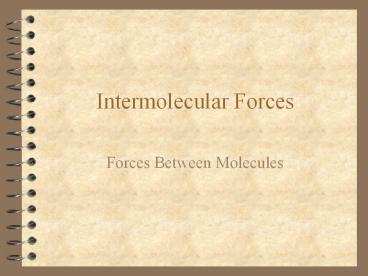Intermolecular Forces - PowerPoint PPT Presentation
Title:
Intermolecular Forces
Description:
Solubility decreases as length of carbon chain increases. As the chain gets longer, more H-bonds in the water must be broken to make room for the alcohol. ... – PowerPoint PPT presentation
Number of Views:865
Avg rating:3.0/5.0
Title: Intermolecular Forces
1
Intermolecular Forces
- Forces Between Molecules
2
Intermolecular Forces
- Electrical forces between molecules causing one
molecule to influence another - Heats of vaporization give a measure of the
strength of attractions present between molecules - the energy required to separate molecules when
changing from liquid to gas state
3
Ionic Compounds
- The forces of attractions in ionic compounds are
the electrostatic force between ions - A relatively strong force
- ?Hvap /100 kJ/mol
4
Molecular Compounds
- Polar Molecules
5
Polar Molecules
- Force of attraction between molecules is a
dipole-dipole attraction - Dipole-dipole forces are smaller than ion-ion
forces - ?Hvap .20 kJ/mol
-
-
Molecules are electrically neutral overall but
organize themselves by attractions of head to
tail dipole orientation
-
-
-
6
Hydrogen Bonding
- A Special Dipole-Dipole Interaction
7
Hydrogen Bonding
The energy of the H-bond depends on the
electronegativity of the X-atom F gt O gt N . Cl
?-
?
?-
?
X-H ....... X-H
8
Heats of Vaporization
non-polar molecule
9
Molecular Compounds
- Non-Polar Molecules
10
Non-Polar Molecules
- Non-polar molecules do not possess permanent
dipoles - Force of attraction between molecules is a London
Force
11
- ?Hvap increases with increasing numbers of
electrons
12
Principles of Solubility
- Solubility is dependent on intermolecular forces
13
Liquid-Liquid
- like dissolves like
- liquids with similar structures (similar type
magnitude intermolecular forces) will be soluble
in each other in all proportions.
14
Example
- Both are held together by London Forces
- When a pentane molecule passes into a volume of
hexane molecules, there is no significant
environment change
hexane
pentane
15
Oil Slicks
- Non-polar substances have little water solubility
- Water molecules are held together by H-bonds
- Non-polar are held together by London Forces
- H-bonds must be broken to dissolve appreciable
quantities of non-polar substances in water
16
Oil Slicks
- For substances to be soluble, there must be
compensation for any forces broken in the
dissolution process. - Since there is no compensating force between a
non-polar molecule and a water molecule, enough
energy is not available to break the H-bonds
17
Water Solubility of Polar Molecules
- Water will dissolve some polar molecules
- CH3OH and CH3CH2OH are capable of forming H-bonds
- Intermolecular forces between these alcohols and
water are similar to those forces in pure alcohol
and pure water.
18
Water Solubility of Alcohols
- Solubility decreases as length of carbon chain
increases - As the chain gets longer, more H-bonds in the
water must be broken to make room for the
alcohol. - Not enough H-bonds can be reformed to compensate
19
Non-Polar Slightly Polar Substances
- Most soluble in solvents of low polarity
- Least soluble in H-bonding solvents
20
The DDT Story
- Soluble in non-polar or slightly polar solvents
- Concentrates in fatty tissue of fish, birds
game - Quite water insoluble
- isnt washed out of contaminated soil
21
Solid-Liquid
- Solids always have limited solubility in liquids
- due to differences in the magnitudes of
intermolecular forces in solid vs. liquid state - at 25oC a solid has much stronger intermolecular
forces than a liquid
22
Solid-Liquid
- The closer a solid is to its mp, the better its
intermolecular forces will match up with a liquid - Typically, solubility increases as the
temperature increases - Low mp solids tend to exhibit greater solubility
than high mp solids































